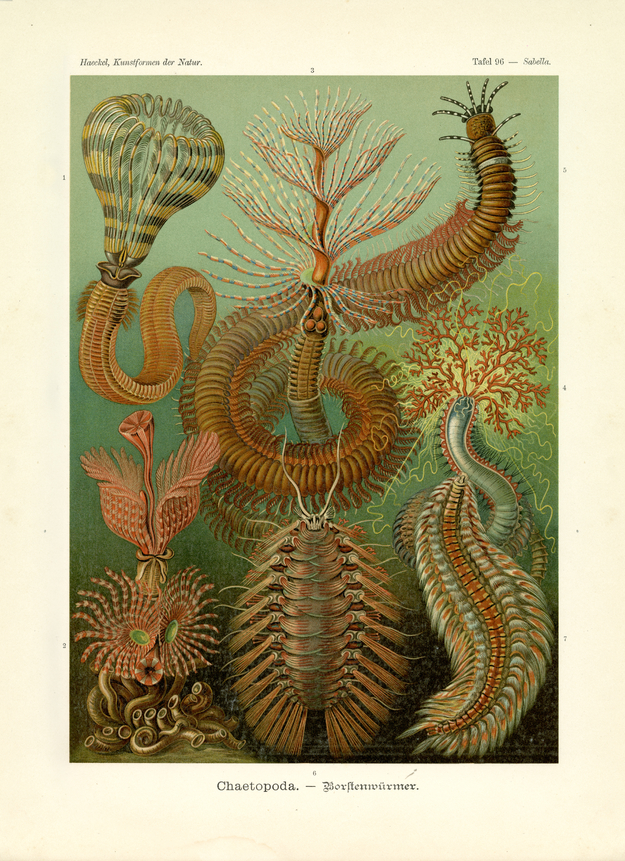Translation of the original German introduction by Ernst Haeckel:
Phylumof Articulata (Gliedertiere); - main class of Annelida (Ringeltiere); - class of Chaetopoda (Borstenwürmer); - subclass of Polychaeta (Borstenreiche).
‘Ringed animals’ or annelid worms (Annelida, also known as Annulata) are usually considered a class of “worms”; it is most essentially distinguished, however, from real, always inarticulate worms (Vermalia, plate 23, 32, 33, 97) by its ‘metamerism’, i.e. by the external and internal structure of the elongated body. Here they resemble the higher standing “limb-footed” (Arthropoda), the two varied groups of crustaceans (Crustacea, plate 56, 76) and the ‘air-pipe-animals’ (Tracheata, plate 58, 66). The latter two main classes are to be understood as two independent main branches of the phylum of articulated animals, originating from two distinct groups of Annelida. All these articulated animals (Articulata) have not only the external ringed appearance of the skin-cover in common, but also the internal organization of the central nervous system (ventral nerve cord), muscular system, vascular system, etc. The older annelids are distinguished from both younger groups of Arthropoda due to the basic fact that individual body segments or rings (Segmenta, Somita, Metamera) are formed homogeneously (homonom) in the former, more or less disparately (heteronom), however, due to division of tasks, in the latter. Furthermore, the legs in annelids (originally one pair in each segment) are short and inarticulate, in most Arthropoda long and articulated.
The main class of Annelida is divided into two classes, leech or blood-sucker (Hirudinea) and bristleworms (Chaetopoda). The skin of the former is smooth and lacks a bristle-cover that distinguishes the latter class. The strong chitin-bristles are of highly varied form, size and order. They are small and scantily developed in the ‘bristle-poor’ (Oligochaeta) to which, among others, the earthworm (Lumbricus) belongs. Bristles are big and numerous in the ‘bristle-rich’ (Polychaeta); they rest on distinct ‘foot-stumps’ (Parapodia) that the ‘bristle-poor’ lack. Usually two pairs of ‘stump-feet’ sit on each body segment, more rarely only one pair. The feet usually carry external gills, ‘sensing-filaments’ and other appendages.
All ‘bristle-rich’ (Polychaeta) live in the sea and are divided into two varied orders: ‘predator-worms’ and ‘tube-worms’. ‘Predator-worms’ (Errantia or Rapacia, fig. 5-7) creep and swim freely in the sea water, carrying gills on most rings. Being strong predators they possess a well developed head, usually armed with jaws. ‘Tube-worms’ (Tubicolae or Sedentaria, fig. 1-4), however, are fixed to the ocean floor; their head is vestigial and carries huge gills; jaws are missing.
Translation by VR Translators Bangalore
We've scanned the original lithography at 1200dpi on the Epson A3 scanner of A3 scanner huren. You can download a 400dpi JPEG here.
